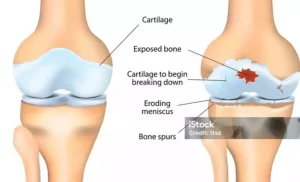Understanding the Intricacy of Osteoarthritis

Osteoarthritis (OA) is a common chronic joint disease that impacts millions of people globally. Notwithstanding its ubiquitous frequency, OA’s complex nature makes diagnosis and treatment difficult. The goal of this page is to give a thorough overview of osteoarthritis, including information on symptoms, diagnosis techniques, and several treatment options..
Understanding Osteoarthritis: This condition is marked by the deterioration of joint cartilage and the underlying bone, resulting in symptoms including stiffness, discomfort, and reduced range of motion. Over time, these symptoms frequently get worse, which lowers a person’s quality
of life and functional abilities. Although osteoarthritis (OA) can affect any joint, weight-bearing joints including the spine, hips, and knees are the most often affected.
Osteoarthritis (OA) symptoms
Depending on the joints impacted and the degree of the ailment, OA symptoms can differ significantly from person to person. Typical signs and symptoms include:
1. Joint Pain: Often characterized as a deep aching or soreness that gets worse with movement and gets better with rest, joint pain is a classic sign of osteoarthritis.
2. Stiffness: Specifically, stiff joints are typical in OA and may go down with movement, especially in the morning or after periods of inactivity.
3. Tenderness: The afflicted joint may feel sensitive to pressure, particularly in the vicinity of the cartilage degradation.
4. Swelling: Joint inflammation and swelling can happen, which can aggravate discomfort and limit range of motion.
5. Reduced Range of Motion: OA can make it difficult for a joint to move through its whole range of motion, which makes daily tasks difficult.
6. Joint Instability: Severe OA can result in joint instability, which makes motion seem like it’s “giving way”
7. Crepitus: As a result of cartilage loss, some people may have a grating or grinding feeling in their joints. This condition is known as crepitus.
8. Bone Spurs: These growths may appear around increasing stiffness and discomfort in the area surrounding the injured joint.
9. Muscle weakening: Muscle atrophy and weakening can worsen joint stability in OA patients with chronic pain and impaired joint function.
Osteoarthritis Diagnosis
Imaging tests, a physical examination, and a medical history are usually used to diagnose OA. Bone spurs, cartilage loss, and joint degeneration may all be seen by X-rays, MRIs, and CT scans. Joint fluid analysis and blood testing may also be carried out to rule out other illnesses that present with similar symptoms.
Management Techniques
The goals of OA management are to reduce symptoms, strengthen joints, and improve quality of life. Potential treatment approaches are as follows:
– Lifestyle adjustments: Joint protection methods, exercise, and weight control can all help lessen discomfort and increase range of motion.
– Drugs: Nonsteroidal anti-inflammatory medications and pain relievers Injections of hyaluronic acid, corticosteroids, and (NSAIDs) may be used to treat pain and inflammation.
– Physical therapy: Activities that increase range of motion, flexibility, and strength can assist to enhance joint stability.
– Assistive devices: To support and stabilize impacted joints, braces, canes, and orthotic shoe inserts may be advised.
– Surgical interventions: Joint replacement surgery (arthroplasty) may be taken into consideration in severe instances of osteoarthritis (OA) in order to replace deteriorated joint surfaces with artificial implants.
In summary, osteoarthritis is a multifaceted and diverse ailment that necessitates a multidisciplinary approach to diagnosis and treatment. Healthcare providers may assist people with OA in properly managing their illness and enhancing their quality of life by comprehending the variety of symptoms associated with the condition and putting individualize




